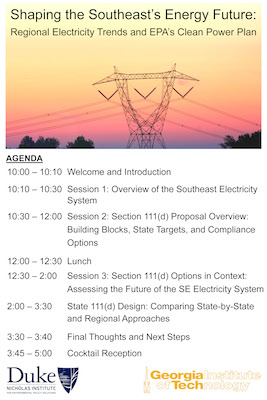
On September 26, 2014, the Georgia Institute of Technology’s School of Public Policy and Duke University’s Nicholas Institute for Environmental Policy Solutions co-organized a workshop focused on Shaping the Southeast's Energy Future: Regional Electricity Trends and the EPA's Clean Power Plan. Hosted by Georgia Tech in Atlanta, the invitation-only workshop engaged a diverse group of nearly 100 participants including air and energy regulators, utilities and energy researchers, industrial energy consumers, think tanks, and environmental advocacy groups. We gathered together to discuss the Southeast’s transitioning electricity sector and EPA’s proposed Clean Power Plan to limit carbon dioxide emissions from existing power plants.
Topics covered included the regional nature of the electricity system; current trends in the Southeast’s electricity sector; key issues raised by the EPA’s proposal; state flexibility in compliance planning; and tradeoffs between individual- and multi-state approaches to managing carbon dioxide emissions.
The workshop began with an overview by TVA's Gary Brinkworh of electric power conditions and trends in the Southeast.
The second session began with an in-depth overview by Duke University's Jeremy Tarr of the proposed Clean Power Plan , including how the EPA calculated individual state targets, the relationship between the state targets and compliance options, and EPA’s guidance on state cooperation. Discussants addressed key issues for the Southeast in response to the proposal.
The third session began with a summary by Georgia Tech's Marilyn Brown of current electricity trends and factors driving these changes, along with a preliminary assessment of 111(d) compliance options and costs, highlighting their regional variations. Discussants offered perspectives on the transitioning electricity system and on section 111(d) compliance options in the context of broader trends.
The final session opened with a brief description of the various potential forms of regional cooperation and the questions that may arise for regulators evaluating state-by-state versus regional approaches. Respondents discussed tradeoffs between individual- and multi-state approaches, key considerations for regional cooperation, and opportunities for informal collaboration.
Closing comments suggested that participants are interested in continuing to discuss these complex issues shaping the Southeast’s electricity future. A range of future follow-on activities are therefore being discussed. We appreciate participants for taking the time to attend the workshop and look forward to more interactions in the future.
Resources:
- PowerPoint Presentation: Regional Electricity Trends and the EPA's Clean Power Plan by TVA’s Gary Brinkworth
- PowerPoint Presentation: EPA's Proposed Power Plan and Multi-State Cooperation by Duke University’s Jeremy Tarr.
- PowerPoint Presentation: 111(d) Options in Context: Assessing the Future of the SE Electricity System by Georgia Tech’s Marilyn Brown.
